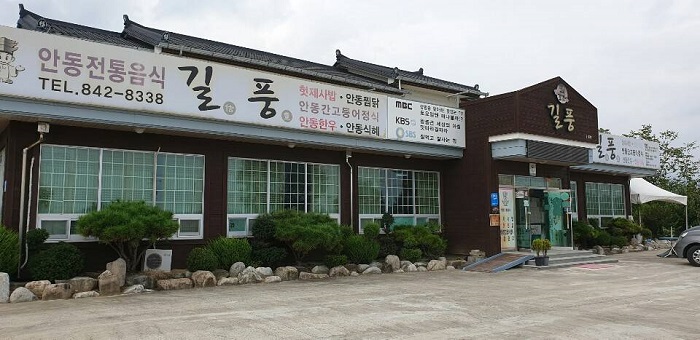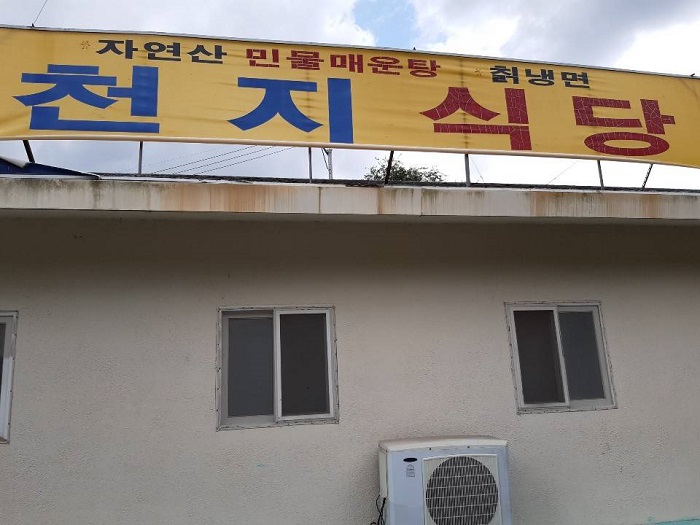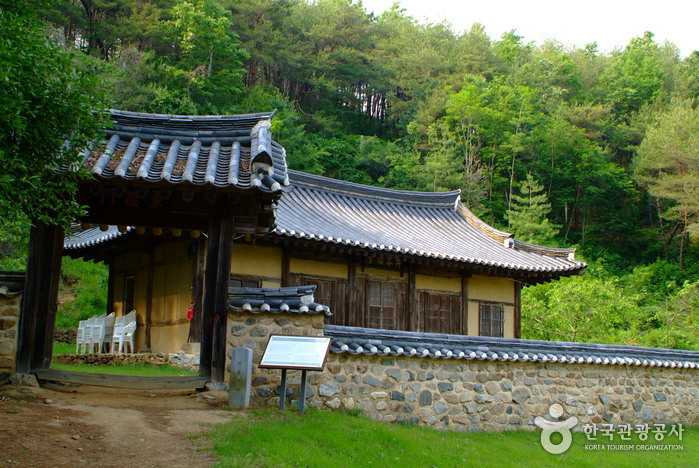Gilpung (길풍)
18.1 Km 45 2021-03-23
8, Nabau-gil, Andong-si, Gyeongsangbuk-do
+82-54-841-9967
It is a clean and delicious restaurant, selected by the Korea Tourism Organization, where you can taste Andong's local food. This restaurant's signature menu is Andong braised chicken. This Korean dishes restaurant is located in Andong-si, Gyeongsangbuk-do.
Cheonji Sikdang (천지식당)
18.2 Km 35 2021-03-24
90, Utjangteo-gil, Andong-si, Gyeongsangbuk-do
+82-54-822-7008
You can eat maeuntang (fish stew) made with fresh freshwater fish. This Korean dishes restaurant is located in Andong-si, Gyeongsangbuk-do. The representative menu is spicy freshwater fish stew.
Dosanseowon Confucian Academy [UNESCO World Heritage] (도산서원 [유네스코 세계유산])
18.2 Km 43897 2024-05-30
154 Dosanseowon-gil, Andong-si, Gyeongsangbuk-do
+82-54-856-1073
In terms of architecture, Dosanseowon Confucian Academy complex can largely be divided into Dosanseodang compound and Dosanseowon compound. Dosanseodang area consists of living quarters and lecture halls where Toegye Yi Hwang, an eminent Confucian scholar, lived and taught his students. Dosanseowon was built after Toegye Yi Hwang passed away by his followers' to honor the legacy of his teachings as well as to pay respects to the deceased.
Built in 1561, Dosanseodang lecture hall is the oldest building in the whole complex. It was personally designed by Yi Hwang, penname Toegye, to further his studies while educating future scholars after moving to the countryside. Living quarters used as a student dormitory were also built along with the lecture hall.
Dosanseowon compound was completed in 1576, six years after Yi Hwang's death. Yi Hwang's ancestral tablet was enshrined inside Sangdeoksa Shrine in 1572. Two years later, Jeongyodang Lecture Hall was built to relocate the tablet and with the addition of buildings to the hall's east and west, the area became a seowon. In 1575, the establishment was bestowed a royal charter and a plaque with the name Dosanseowon written by Han Seok-bong, and became the Confucian academy headquarters in the Yeongnam region.
Andong Hanji (안동한지체험)
18.2 Km 14997 2020-01-30
13, Nabau-gil, Andong-si, Gyeongsangbuk-do
+82-54-858-7007
Andong Hanji, located at the entrance of Hahoe Village, an area preserving Korean traditions and customs, has done its best to continue the manufacturing of traditional Korean paper, hanji. Andong Hanji makes hanji using Korean paper mulberry and clean water. The center features many items made from hanji, and offers experience programs for students, as well as factory tours to learn more about the complete production process. Andong Hanji is proudly produces the largest amount of exceptional quality hanji in approximately 60 different types for various uses.
Songgyehyeon [Korea Quality] / 송계헌 [한국관광 품질인증/Korea Quality]
18.5 Km 0 2021-03-25
332, Byeongsan-gil, Andong-si, Gyeongsangbuk-do
This hanok (traditional Korean House) lies only 500 m away from Andong’s Byeongsanseowon Confucian Academy. Byeongsanseowon Confucian Academy is one of the Confucian academies (Joseon-era places of learning and veneration of Confucian scholars) registered as a UNESCO World Heritage, and is particularly known for its beautiful harmony with the surrounding nature. Songgyehyeon likewise faces the Nakdonggang River to the front, and a 330 m-high mountain to the back, displaying the characteristic harmony of hanok with nature.
The house was named Songgyehyeon by the owner, who wanted to build a house made out of pine trees (“song”). The entire house is offered for rent, which makes it ideal for families and groups. Songgyeheon follows a strictly traditional structure of hanok, as evident in its hipped-and-gable roof, but its interior is equipped with comfortable modern facilities. The house includes both bedrooms and Korean-style ondol (under-the-heating system) rooms. One of the three bedrooms available has a queen-sized bed, while the remaining two are equipped with comfortable mats. The common space, spacious enough to host a group, has a high ceiling dominated by exposed beams. The kitchen is equipped with cooking equipment like refrigerator, gas stove, microwave oven, and utensils for guests to cook their own food. The owner of the house also enthusiastically provides detailed information on Andong’s many tourist sites.
Jirye Arts Village (지례예술촌)
18.5 Km 28458 2024-05-29
427 Jiryeyesulchon-gil, Andong-si, Gyeongsangbuk-do
+82-54-852-1913
Located in Andong, Jirye Arts Village first formed as a result of the construction of Imha Dam. When a small neighborhood in Jirye-ri, Imdong-myeon was at the risk of flood due to the dam, Kim Won-gil, the village leader at the time, relocated and rebuilt ten houses to the current location in 1986. This neighborhood, now known as Jirye Arts Village, was designated as an art village in 1990 and since then, many artists settled in the neighborhood and formed a community of culture and art. Today, Jirye Arts Village offers a variety of opportunities to experience Korean culture through hands-on arts and crafts as well as diverse cultural activities.
Hakgasan Recreational Forest (학가산자연휴양림)
18.6 Km 24487 2021-06-15
210, Hyuyangnim-gil, Yecheon-gun, Gyeongsangbuk-do
+82-54-652-0114
Hakgasan Recreational Forest is located in a valley on the northern side of Hakgasan Mountain, known for its clean air. The recreational forest has log cabins that harmonize with the nearby trees, creeks, and rocks, making visitors feel as if they are resting at a luxury villa. It is an ideal vacation destination for those who want to get closer to nature. There is a hiking path leading to the summit of Hakgasan Mountain from the forest, taking around 2 hours. Additional amenities within the forest include campfire pits, an outdoor stage, children's playground, exercise equipment, water play area, a lecture hall, and more.
Byeongsanseowon Confucian Academy [UNESCO World Heritage] (병산서원 [유네스코 세계유산])
18.9 Km 32619 2024-05-29
386 Byeongsan-gil, Andong-si, Gyeongsangbuk-do
82-54-858-5929
Before it became a Confucian academy, Byeongsanseowon Confucian Academy was originally located in Pungsang-hyeon under the name Pungakseodang School, which was used as a educational institution since the Goryeo dynasty by a political party known as the Sarim Party. It was moved to its current location in Byeongsan by a well-respected Confucian scholar named Yu Seong-nyong, penname Seoae, in 1572, and renamed to Byeongsanseowon in 1614.
In 1863, Byeongsanseowon was recognized by the king to receive support as a private Confucian academy. The lecture hall and shrine were reconstructed in 1921 and 1937 respectively as part of preservation efforts made during the Japanese occupation. This academy is designated as a Historic Site, housing a collection of 1,000 documents and 3,000 books, including works by Yu Seong-nyong.
Yangsodang[Korea Quality] / 양소당[한국관광 품질인증]
19.0 Km 11079 2024-07-01
28 , Jangtaegol-gil, Andong-si, Gyeongsangbuk-do
+82-10-9005-0891, +82-10-5260-9565
Yangsodang is the head house of the Andong Kim Clan, which dates back 230 years and is located in Sosan Village in Andong, Gyeongsangbuk-do. Being a true hanok built by joining wood without nails, this house is a perfect place to take in the beauty of traditional Korean architecture. There are five guest rooms, including the Anchae Anbang (main room in the main building), a large ondol (underfloor heated) room across from the Anchae (main building), and a large Sarangchae (detached building) that has two rooms with a maru (wide wooden floor area); all of the rooms, except the small room, have either a daecheong maru (wooden-floored living room) or toenmaru (narrow wooden porch). In the yard east of Yangjo-dang, you can experience what it is like to live in a hanok, as well as participate in craft activities using Hanji (Korean paper).



![Songgyehyeon [Korea Quality] / 송계헌 [한국관광 품질인증/Korea Quality]](http://tong.visitkorea.or.kr/cms/resource/42/2706142_image2_1.jpg)

![Byeongsanseowon Confucian Academy [UNESCO World Heritage] (병산서원 [유네스코 세계유산])](http://tong.visitkorea.or.kr/cms/resource/63/2620863_image2_1.jpg)
![Yangsodang[Korea Quality] / 양소당[한국관광 품질인증]](http://tong.visitkorea.or.kr/cms/resource/55/2803255_image2_1.jpg)
 English
English
 한국어
한국어 日本語
日本語 中文(简体)
中文(简体) Deutsch
Deutsch Français
Français Español
Español Русский
Русский